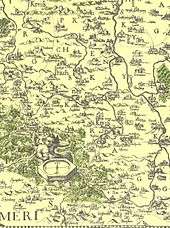Prácheňsko
Prácheňsko (German: Prachens; Latin: Provincia Prachinensis) is a historical and cultural region in the Czech Republic, covering roughly the Otava River basin, mostly in the northwest part of South Bohemia. It was an administrative region (kraj) in southwestern Bohemia, created in the late 13th century and abolished by the Austrian Empire's regional reform of 1848.[1]

Description
Its boundaries extended through the Bohemian Forest in the south, towards Budweis (České Budějovice) to the north, close to the town of Příbram, and southwest to Markt Eisenstein (Železná Ruda). Ethnic groups of the region included Czechs, Germans, Jews and Romani, and by religion were Roman Catholics, Protestants (Utraquists) and Jews. Today this region is divided among three districts, namely South Bohemia (vast majority), Plzeň Region and Central Bohemia. Its capital city was Písek (a great medieval city until its devastation in 1620 during the Thirty Years' War), now a major town of approximately 30,000 inhabitants.
The first region′s centre, Prácheň gord (which gave its name to the whole region), is now overtaken by forest. Its remains lie close to the town of Horažďovice. The local dialect of the western part is still extant as is the use of the bagpipe in the music of the region. The main geographical feature of the Prachens region is the river Otava (or in the local dialect Wotāva). Principal towns of the former Prachens were Písek (or Pisek in German), Strakonice (Strakonitz), Sušice (Schüttenhofen or Setuakaton in its Celtic form), Rožmitál (Rosenthal), Vimperk (Winterberg), Horní Planá (Ober Plan), Železná Ruda (Markt Eisenstein), Kasejovice (Casseudz, Kasejowitz), Protivín (Protiwin) and Horažďovice (Horaschdowitz).
Demographics
The current population of the region is approximately 200,000 to 250,000 inhabitants. The area suffered serious population losses because of the Expulsion of Germans after World War II (about 25% of the population, mostly in the southern part) and because of the Holocaust (השואה or חורבן). Today the Jewish population is negligible and there is no active synagogue.
A unique dialect of the Czech language with a large number of German loan words is spoken in the western part of the region.